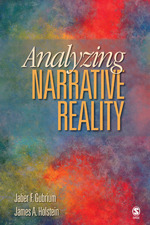Analyzing Narrative Reality
- Jaber F. Gubrium - University of Missouri, USA
- James A. Holstein - Marquette University, USA
Case Study & Narrative Analysis | Qualitative Research (General) | Social Research Methods
Analyzing Narrative Reality is truly multidisciplinary and should appeal to researchers working across the social and behavioral sciences and humanities, as well as to narratively focused researchers in nursing, education, allied and public health, social work, law, counseling, and management/organization studies.
This book is one of the few that have a wider perspective on narration. It is not only about classical elements already known from narration analysis, it is also about social contexts and environments in which stories are told as well. It is the next step in narration research because it builds a first bridge from humanities to social sience. As statet in the titel, it combines narration with reality.
This book is excellent but more theoretical than what I need for my research course.
Excellent book for qualitative researchers.
In the context of narrative the can be an additional reading text
Somewhat too theoretical for the course, but gives interesting viewpoints and some analysis too. it is not focussed on business studies enough, thus its relevance is not the best one. a good book for those student who want to understand narrativity deeper that ordinary business students.
The book will be recommended to research methods students.
A very useful text that offers a sensible approach for exploring narratives and considering how to read them in research. Have ordered for the library and am recommending to students for use with qualitative analysis on this course and also for a research project course. Will recommend for the EdD course too.
An excellent text for anyone undertaking narrative research. Recommended text for students undertaking qualitative data analysis for dissertation



